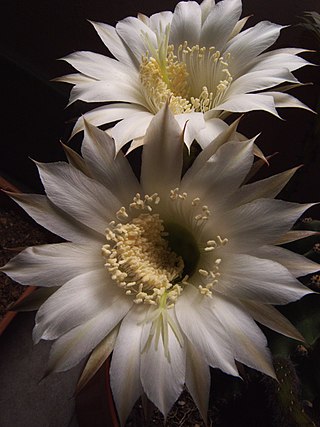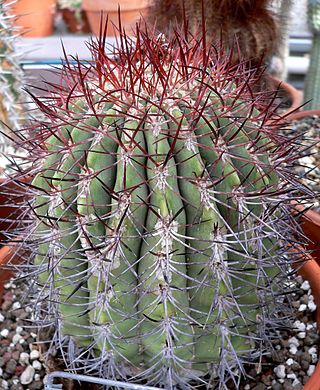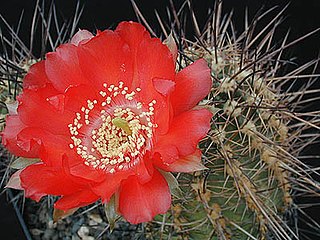
Echinopsis is a genus of cacti native to South America, sometimes known as hedgehog cactus, sea-urchin cactus or Easter lily cactus. As of October 2023, there are about 20 accepted species, ranging from large and treelike types to small globose cacti. The name derives from echinos hedgehog or sea urchin, and opsis appearance, a reference to these plants' dense coverings of spines.

Matucana is a genus of cacti, containing approximately 20 species of mostly globular plants. The genus is known only from Peru, mostly along the Marañón River.

Vatricania is a monotypic genus of flowering plants belonging to the family Cactaceae. It contains just one species, Vatricania guentheri. It has the common name of red tail cactus.

Mila caespitosa is a species of cacti and the only species of the genus Mila. Its generic name is an anagram of Lima, Peru, the city near which the plant is found. The genus was first thought to comprise 13 species, until recent studies suggest they form one very variable species.

Samaipaticereus is a monotypic genus of cactus containing the sole species Samaipaticereus corroanus. It is known only from East Andean Bolivia and Peru.

Echinopsis oxygona, also known as Eyries cactus, Easter lily cactus or sea-urchin cactus, is a species of flowering plant in the cactus family Cactaceae, native to south Brazil, Uruguay, Paraguay and northeastern Argentina. Some species that have been described separately, including Echinopsis eyriesii and Echinopsis tubiflora, are now considered to be synonymous. The features of the species include a large flower, with sharply pointed lavender or white petals, and a sweet scent.

Ferocactus glaucescens, the glaucous barrel cactus, is a species of flowering plant in the family Cactaceae, native endemic to México.

Lobivia cinnabarina is a species of cactus first described in 1885.

Denmoza is a monotypic genus of cacti. Its only species, Denmoza rhodacantha, is native to northwest Argentina.

Soehrensia formosa, is a species of Echinopsis found in South America. In north-western Argentina, Bolivia and northern Chile. First published in Cactac.: Handb. Kakteenk. 3: 1678 in 1959.

Echinopsis haematantha, is a species of Echinopsis found in Argentina and Bolivia.

Soehrensia huascha, is a species of Soehrensia in the Cactaceae family, found in north western Argentina. First published in Cactaceae Syst. Init. 29: 5 in 2013.

Lobivia pentlandii, is a species of Lobivia found in Bolivia and Peru.

Echinocereus scheeri is a species of hedgehog cactus in the family Cactaceae, native to northern Mexico. With its dramatic offsets, it has gained the Royal Horticultural Society's Award of Garden Merit.

Acanthocalycium rhodotrichum is a species of Acanthocalycium found in Argentina, Bolivia, Brazil, Paraguay, and Uruguay.

Matucana haynii is a species of Matucana found in Peru.
Soehrensia walteri is a species of Soehrensia found in Argentina.
Soehrensia quadratiumbonata is a species of Soehrensia found in Bolivia.

Echinocereus scopulorum is a species of cactus native to Mexico.

Echinocereus pamanesii is a species of cactus native to Mexico.





















